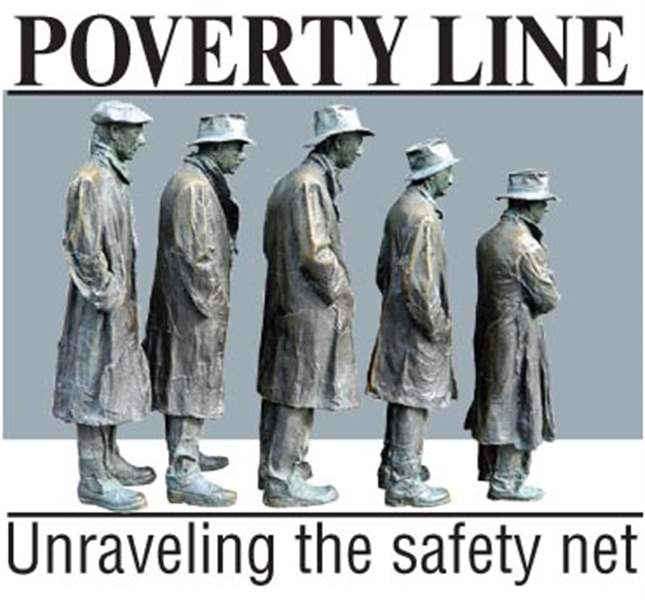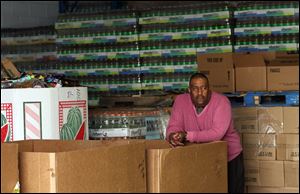
POVERTY LINE
Questions arise over need for 2 food banks in Toledo
3/22/2009

With the national economy battering the Toledo area, The Blade this year will examine poverty and the region’s readiness for the turmoil caused as more people lose their jobs. Today, we look at Toledo’s two food banks.
When the cupboards are running bare at the 14 food pantries he manages, the Rev. Steve Anthony looks to one of northwest Ohio's two food banks to restock his shelves.
Whether Mr. Anthony, the executive director of Toledo Area Ministries, calls the Toledo Northwestern Ohio Food Bank or Toledo Seagate Food Bank often depends on the products he needs, when he needs them, and whether it will cost his organization.
"Each specializes in what they do," said Mr. Anthony, whose organization last year served 73,000 people across the Toledo area, an 18 percent increase from 2007.
But because the food banks offer the same service and supply much of the same food for many of the same people and organizations, some of those who work with the poor are asking: Why does northwest Ohio need two food banks?
The answer, some say, is that during the past two decades the food banks have established their own identities, built their own histories, and carved out their own niches.
But a Blade analysis of food bank finances shows that although both food banks are doing their parts to make food available for thousands of residents across the region, they often duplicate their administrative costs as they coexist in the community.
READ MORE: Poverty Line -- Unraveling the safety net
Operating separately, the not-for-profit, tax-exempt food banks employ two staffs at a cost of $265,000 each, pay two executive directors, occupy two sets of buildings, and compete for donations.
Food banks are established to be wholesale operations that link state, federal, and national charity food programs with local food pantries and kitchens that distribute food to the poor.

"Could the community benefit from one food bank instead of two?" pondered Mr. Anthony, whose organization is among the largest clients of both food banks.
"We'd only know if we tried it," he said. "On paper, it seems like it would be true. But how it would operate and who would be in charge - that's beyond what I'd like to comment on."
Toledo is the only city in Ohio with two major food banks, and that causes Bill Kitson, president and chief executive officer of United Way of Greater Toledo, to question whether the region is benefiting.
"Most communities only have one food bank, so you could image a scenario where a single food bank would be more efficient for our community," Mr. Kitson said. "Obviously, both food banks serve specific roles, and they've grown into those roles, so this might be a difficult thing to do. But if this were starting over, you wouldn't create two food banks."
The food banks both argue that they serve distinct purposes and are necessary for the community.
James M. Caldwell, the president of the Toledo Northwestern Ohio Food Bank, said there are many examples of cities across the country that have two major food banks, including Seattle and Spokane.
"It depends on the community. It depends on the need and if we want to support one entity or another," Mr. Caldwell said.
In Toledo, Mr. Caldwell said, "We both serve a purpose. We both are feeding people."
A complex setup
The Toledo Northwestern Ohio Food Bank, founded in 1984, operates on revenues of about $5.3 million and receives the bulk of its funding from Feeding America, formerly known as America's Second Harvest, the nation's largest charity for feeding the poor.
According to its most recent government filing, its largest contributors include Mid-Ohio Salvage, Smucker's, Walgreens, Summit Street Packing, and Sofo's.
"We operate a pretty lean machine," said Mr. Caldwell, who has directed the Toledo Northwestern Ohio Food Bank since 1995.
Questions from BBB
Through a complex arrangement among the three Toledo not-for-profits, Mr. Caldwell is paid $152,000 a year to manage the food bank, Second Harvest Community Services of Northwest Ohio, and the James C. Caldwell Center, which was named for his father, the center's longtime executive director.
The food bank pays about $67,000 toward Mr. Caldwell's salary. The James C. Caldwell Community Center, a family resource center with programs for children and adults, and Second Harvest Community Services of Northwest Ohio, which is the parent organization of the food bank and the Caldwell center, pay the $85,000 balance of Mr. Caldwell's salary.
Deb Vas, who runs the Toledo Seagate Food Bank, which has annual revenues of $4 million, was paid $31,200 last year, according to tax filings.

James M. Caldwell of Toledo Northwestern Ohio Food Bank says his agency receives the bulk of its funding from Feeding America and is ‘a pretty lean machine.’
Mr. Caldwell explained his responsibilities and compensation by saying he has final say over the operations of both entities and he hires others to run the day-to-day operations.
"The buck stops with me," Mr. Caldwell said. "I'm responsible for three corporate entities. I'm responsible to make sure they meet their goals and operations."
The complex arrangement among the three charities has caught the eye of Greg Heldt, the Toledo Better Business Bureau's director of charity review, who believes the organization is structured in a way that reduces transparency.
"A really good charity has excellent checks and balances in place," Mr. Heldt said. "I can't say this charity has checks and balances in this place. They have awful checks and balances. The potential for problems is obvious, really."
Mr. Caldwell said the food bank adheres to intensive audits in coordination with its arrangement with Feeding America, and it undergoes a yearly audit by an outside firm.
"The Toledo Northwestern Ohio Food Bank Inc. is committed to transparency in both our governance and operations," Mr. Caldwell said in an e-mail..
Mr. Caldwell said his salary is on par with directors of similarly complex organizations. He has received pay increases during the past three years averaging 10 percent, according to IRS filings.
Mr. Caldwell said the pay increases were a result of the growth of the organization's programs.
Overhead costs
The Toledo Northwest Ohio Food Bank paid its about a dozen employees $275,000 in salaries in 2007, according to its most recent IRS filing.
The bank also spent $126,000 on professional fund-raising fees, $16,500 on advertising, $12,000 on dues and memberships, $40,000 on occupancy costs, $21,000 on travel, $4,000 on professional fees, and $16,000 on miscellaneous expenses.
Mr. Caldwell said food bank staff members travel to Columbus or Washington to meet with legislative leaders and participates in meetings on how to improve services.
The fund-raising expenditures, Mr. Caldwell said, reflect that the food bank contracts with a national organization that develops direct mail programs and newsletters for many food banks.
The Toledo Seagate Food Bank, which distributes for two federal programs and has 10 paid employees, had a payroll of $265,000 last year.
Seagate spent $60,000 on consultants and promotions, which included advertising costs.
The organization also spent $13,000 on travel transporting food in the state.
Mr. Kitson of the United Way said the costs of running two food banks are significant.
"I'm concerned about every nonprofit's overhead costs," Mr. Kitson said. "These operations are expensive. Unrestricted dollars to fund overhead are hard to find. Any time there is unnecessary overhead, you have to call it into question."
Ms. Vas, who runs the Toledo Seagate Food Bank, which was founded by her mother, Alice Mosiniak, said each of the food banks gets support from various parts of the community for different reasons. Sometimes it is as simple as what kinds of food they have; other times it's about storage fees.
Perhaps Ms. Vas' most compelling argument for the need for two food banks is the increasing need in the community.
"With the numbers we are seeing, maybe two food banks are a good thing," she said.
Either way, Ms. Vas isn't willing to allow Toledo Seagate Food Bank to disappear without a fight.
"We are not going away," she said. "We are integral in this community in the way we operate."
Contact Steve Eder at:
seder@theblade.com or
419-304-1680.